Colony
Confidential - What Really Goes on Inside the Hive
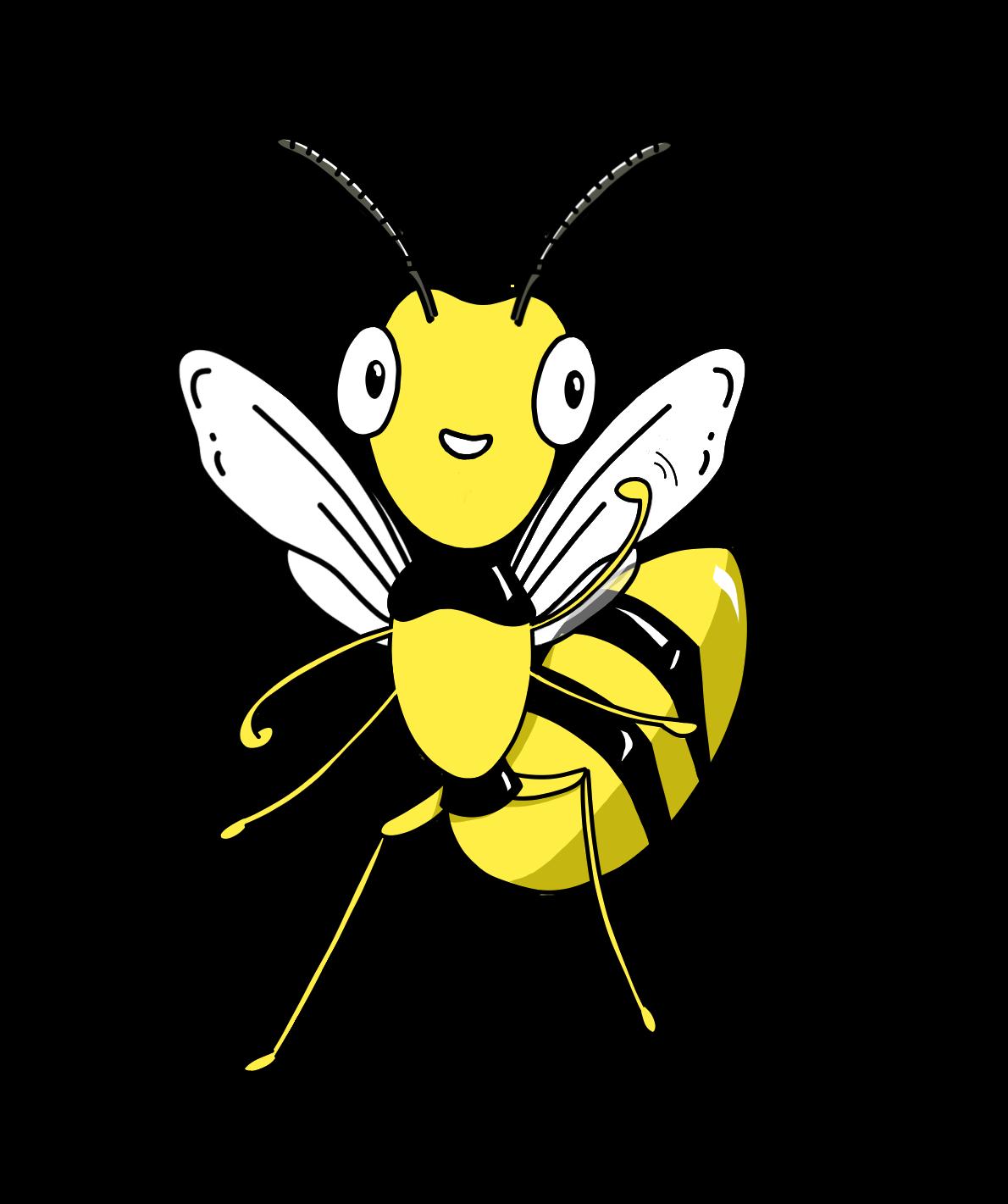 By Peter Keilty and Bridget White
By Peter Keilty and Bridget White

 By Peter Keilty and Bridget White
By Peter Keilty and Bridget White
“Must you really go, my Queen?” Dahlia stood by her mother as attendants fussed and fawned over their matriarch. Some groomed her, while others placed sweet morsels between her mandibles.1 How the young bee envied them for their time spent with the Queen. On a day like today, she almost hated them.
“You know I must, my angel.” replied the elder bee. “I have reigned longer than most. It’s time to seek out a new queendom.”2 Queen Daphne shooed her courtiers away, glad for a moment’s reprieve from their primping. “I could always bend the rules a little for my favorite daughter. Take you with me,” she smiled. The courtiers listened
1 The queen’s main task is to lay eggs. Everything else is provided for her by worker bees who feed and groom her, and even carry away her waste.
2 On average, a queen will remain in the hive for 2-3 years. Eventually this colony will raise a new queen and the old queen will leave with half of the colony to seek out a new hive.
3 Despite having a “queen” the colony is more a democracy than a dictatorship.
4 A bee’s compound eyes are made up of 6,700 lenses or “facets.”

5 The youngest bees are assigned “nurse” duty, and those aged 7-14 days produce royal jelly.

6 The first queen to emerge will kill the other queens before they can hatch.
in, greedy for gossip, until the Queen stopped them with a withering glare.
Dahlia smiled back, sadly. “The others have decided, mother, and my role is here. The Quorum has spoken.” She had always admired the colony’s democracy, until now.3 She felt cheated but, deep down, knew it was for the best.
Dahlia saw herself reflected in the thousand facets of her mother’s kind eyes.4 Her Queen had taught her to be strong, but right now she felt like an awkward hatchling, the confident bee of 16 days nowhere to be found. “However, I must speak to you about …”
“The Queen-in-Waiting,” nodded her mother, slowly. “I know, my sweet. It’s written all over your face. But you must accept her as Monarch after today. For the colony to prosper, everyone must do her and his part.”
Dahlia had been there when her stepmother had first emerged. “Wisteria”, she now called herself, but Dahlia knew her when she was just an egg. She was 7 days old at the time, and being put on queen-raising duty was the highest honor she could think of.5 She had lovingly fed the future tyrant with her own royal jelly, often tired and miserable from the effort. But it had all been worth it, or so she had thought.
The night Wisteria emerged was one of horror for Dahlia. She had rushed to greet the heir to the Queendom, but was met with a sneer, as Wisteria stretched out to her full length and purposefully stalked over to where her sisters, her rivals, lay. Murder had been in her eyes that night. Oh, Dahlia knew that was the way of things, but her mother had always told her it was a thing of necessity: no malice, no pleasure taken in killing. But she had watched the future Queen exult as she plunged her stinger over and over into her sleeping sisters,6 cementing her place on the throne with cruel authority.
The young bee kissed her Queen for the last time, and turned away. “You can rely on me, mother. Duty first. Always.”
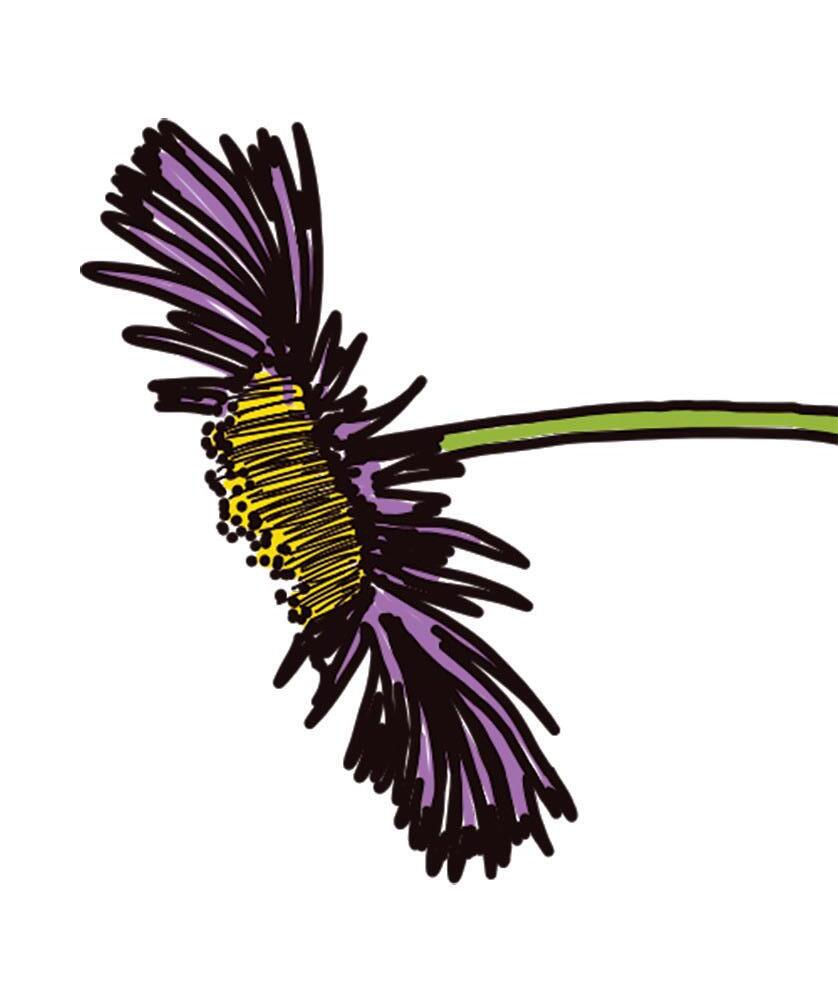
“Sad day for you, eh, Dahlia?” said Narcissus, not unkindly, nodding toward the Royal procession making its way to the hive’s gates. Dahlia continued watching in silence, but she was glad for her oafish brother’s presence that day. With so much changing around her, anything familiar, however annoying it may be, was a blessing.
Narcissus was barrel-chested, with big eyes and an optimism matched only by his vanity.7 He was also only her half brother,8 of which she reminded him often due to his slow wits and fondness for staring at his reflection in puddles. He never noticed, anyway. He was usually too busy working out, or combing his hair until it sat just right, in preparation for the “big day” as he called it.9
“It’s survival of the fittest out there, Dahlia,” he would tell her. “Got to look my best.” Dahlia smiled at the memory: anything to distract from current events. Her mother had ruled with kindness, but she feared Wisteria would be a very different sort of Queen.
“End of an era, that’s what it is.” Dahlia jumped as the veteran Azalea appeared on her other side. Lithe and strong from weeks spent buzzing from flower to flower, she had a confidence Dahlia envied. Not the ragged wings and battle scars, though.10 Those she could live without.
7 Drones are the males of the colony. Their bodies are bulkier and they have big eyes for locating queens with which to mate.

8 Drones come from unfertilized eggs, and therefore only possess the queen’s genes.
9 A drone’s sole purpose is to pass on the colony’s genes, through mating.
10 Older bees forage for nectar, pollen and water. Many dangers await them outside the hive, and traveling miles each day means a lot of wear and tear for their wings.
11 Some crab spiders can change body color between white and yellow, depending on where they want to stage an ambush.
Dahlia had just begun the next chapter in her life as a forager, with Azalea her mentor. Only a day earlier, her elder sister had saved her from flying right into the claws of a hungry crab spider, lying in ambush by the hive gates.11 Dahlia was determined to repay that kindness, and to prove to her sister she was worthy of graduating “flight school,” as Azalea called it.
The Queen had finally reached the gates, and Dahlia could look no more. She turned away, eyes moist, not wanting to show weakness. But a caring hand gently clasped each shoulder, one gnarled from hard work, the other softer and more manicured than the Queen’s, and she allowed herself to hope.
Next month: Dahlia discovers life outside the hive is no less treacherous than within!
Peter Keilty is a beekeeper and pollinator conservationist living in Austin, Texas. His focus is on beekeeping as a means of educating and spreading awareness regarding the plight of pollinators, and native bees in particular.

Peter’s latest initiatives include: creation of the first (of hopefully many) “pollinator neighborhoods,” where an entire community comes together, through beekeeping, to protect pollinators by mindful stewardship of their land; and the Hurricane Dorian Pollinator Conservation Initiative, which again uses beekeeping to promote native pollinator recovery, as well as teaching a valuable skill to local residents affected by this disaster. Beesforall.com/@beesforall
After three years working on insect protein as a sustainable food source, Bridget White is now undertaking her master’s in entomology at the University of Manitoba, Canada. She also serves as the Youth Encouragement and Public Education Chair for the Entomological Society of Manitoba, and strongly believes in using her talent for art to educate and inspire others on the value and wonder of insects. @bri.bugs

Is she late or am I early? Dahlia was still getting the hang of telling time, having never left the hive until a few days ago. The angle of the morning sun seemed right, but she was sure Azalea would be there by now if it were.
She rubbed absently at the three eyes on top of her head. They still ached from the sun, but her sister had assured her it would pass. Dahlia hadn’t even noticed she had five eyes until the day she first stepped outside, but she kept that embarrassing admission to herself.1
Whoosh! Guard bees by the hive gates went sprawling, as her sister rocketed out
and away. “Come on, Dahlia!” shouted Azalea over the furious buzz of her wings. “I won’t have my trainee sunbathing on the job. Let’s get to it!” Dahlia took off in a hurry, joining her teacher in a wide loop around the hive.2
“Big rock, dead tree, round pond. Big rock, dead tree, round pond,” chanted Dahlia, just as she’d been taught.

“Atta girl. We can’t be getting lost now, can we?” replied Azalea.
Dahlia smiled. Azalea’s positivity was infectious and it combined with the fresh morning air to blow the young bee’s worries away, for now at least.
Ahead lay a dark, twisted wood, beyond which they’d been told a riot of wildflowers lay waiting. Lobelia, a new forager like Dahlia, had done her best attempt at a waggle dance the evening prior, but her choreography had needed a lot of work.3 The walls of the hive had shaken with laughter as the veterans watched her perform. It was a very nice dance, Dahlia had thought, but translated to utter gobbledygook! After a few pointers from the elder bees, Lobelia was able to tell them where a rich patch of flowers lay, and they’d all agreed it sounded well worth a visit in the morning.
1 Honey bees have three “ocelli” on top of their head for navigation.
2 Bees new to foraging take several orientation flights, making a note of landmarks to guide them back home. Once they memorize the hive’s location, they no longer need these flights.
3 Bees convey the location and distance of good food sources using a specialized dance.

4 The ideal flight temperature for bees is 72-77 degrees Fahrenheit. Below 54 degrees, they will not be able to fly.
5 Human eyes base their color combinations on red, blue and green. For a bee, it’s ultraviolet light, blue and green. Bees cannot see reds, but can see patterns on flower petals that are invisible to human eyes.
6 Forager bees up to 21 days old will generally collect pollen. Those over 21 days switch to collecting nectar.
7 Orb-weaver spiders prey on honeybees and other flying insects. Some have even been known to construct their webs directly in front of beehives, for an easy meal.
Darkness descended as they entered the treeline. “Stay focused, Dahlia! These woods are alive with danger,” warned her mentor. The young bee’s eyes adjusted to the gloom, and she saw what lay hidden among the trees: death, lurking in every nook and crevice. Dahlia flew a little closer to her sister, hoping the elder bee wouldn’t sense her fear. An oil-black bird, like a piece of shadow that had detached itself from the rest of the darkness, leered at them from a branch above. It was too damp and too chilly for the young bee’s liking, and she felt sluggish and out of sorts.4
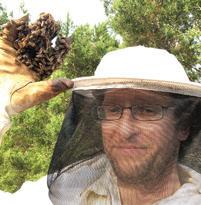
 by Peter Keilty, with illustrations by Bridget White
by Peter Keilty, with illustrations by Bridget White
Up ahead, a glimmer of gold fought its way through the murk and, as the shadows receded, Dahlia saw a fiery embroidery of color draped over the ground beneath them. A meadow of yellow and orange and purple, where every bloom seemed to yell out, “Land here!” A thousand bullseyes, beckoning her in. 5
Dahlia gasped. “Az’, it’s …”
“Beautiful, yes, but stick to the mission,” cautioned the experienced bee. “You’ll collect pollen here and I’ll be close by, in case you get into trouble. Up there.”6 Azalea motioned to a large tree at the edge of the clearing, festooned with fragrant white blooms. Dahlia could smell their sweet, vanilla scent on the breeze.
“It’ll take forever to get this off,” Dahlia complained to no one in particular, as she molded and stuck the soft, orange pollen to her hind legs. “Azalea gets to gulp down nectar and I’m …”

She froze. Azalea’s contented, low buzzing, just at the edge of her hearing, had turned high-pitched and angry. The young bee took off at a speed she didn’t know she possessed, scattering two fluffy bumblebees in a puff of purple pollen.

“No, Dahlia, stop right there!” The silver filaments of Azalea’s prison were almost invisible, and the young bee halted just in time: wings flexing, muscles burning with effort. In the center of the web sat a monster of acid yellow and midnight black: a queen of a different sort, secure and all-powerful on her throne.7
“Look at me!” Azalea commanded. “Do you remember your way back to the hive?”
“I mean, yes, but that’s not … why are you asking me that? I don’t think it has even noticed you, yet. If I can just ...”
“It hasn’t moved yet because it knows I’m stuck fast, little one. I’m done, so why should it rush?”
A heat welled up from deep inside Dahlia, somewhere between fear and rage. “Hold on, Az. Just hold on. That’s an order!”
And with that, Dahlia shot away in the direction of the woods, no longer afraid of the darkness. She had bigger worries, now.
“The cheek!” the older bee half-smiled, with one eye on the impending doom above her. “Giving me an order.”
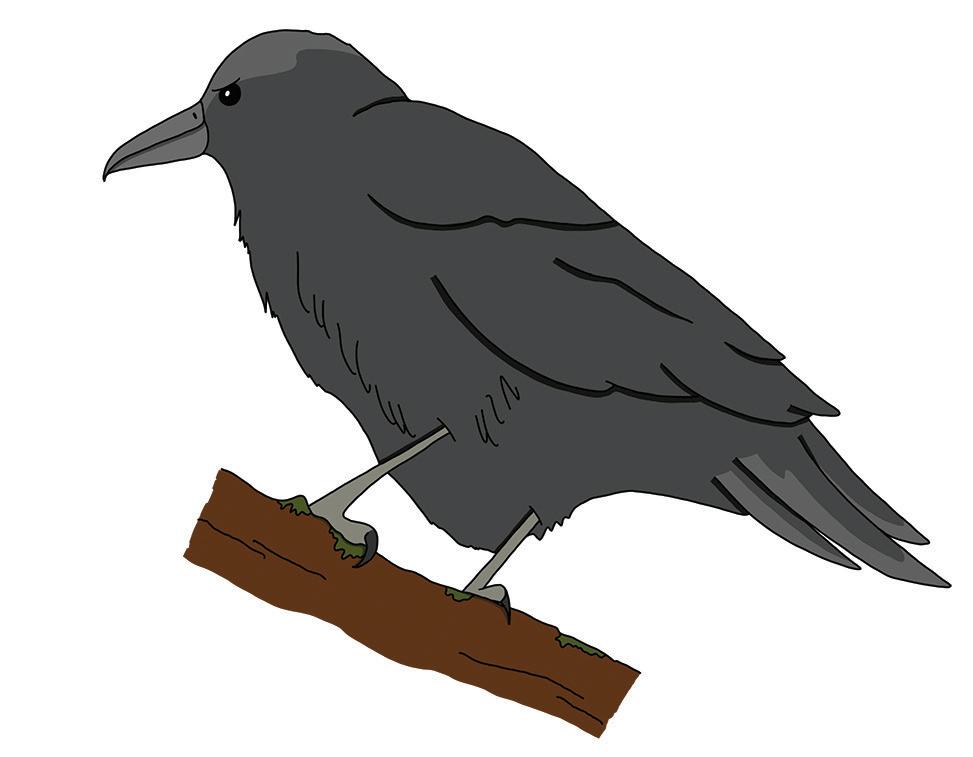
“How are you this heavy?” grunted Dahlia, as she tried to drag her brother out of the hive.
“That’s pure muscle, that is,” Narcissus replied. “Look, Dahlia, you know it’s against the rules for me to leave on a mission like this. I have one job to do, and I can’t mess up. Wisteria’s been watching us like a hawk, lately. And you know my feelings toward birds!”
“Forget Wisteria! Our sister’s in danger, and if you don’t help me …”
“Yes?”
“If you don’t …”
“Go on …”
“I’ll ... I’ll … I’ll wait until you’re asleep one night and cut all your hair off! Try attracting that fancy queen from the next field over, look ing like that.” Narcissus pondered this for what seemed like an eternity.
“I’ll get my coat.”
Together they raced through the gloom — the squawks, cackles and hoots of the woods residents just audible over Narcissus’ constant complaining. “You may not have cut off my hair, Dahlia, but the humidity in this wood is the next best thing.”
1 Worker honey bees collect tree sap and mix it with saliva and beeswax to create “propolis,” which they use to coat the inner surfaces of the hive. Propolis has powerful germ-killing properties, and is also good at keeping the hive sealed from the elements.
2 Drone bees have larger eyes than their female counterparts. Their excellent vision helps them locate queen bees for mating.
3 Spider silk is five times stronger than steel.
4 A tablespoon of honey contains 64 calories of energy.
5 The term “bee-line” is used to describe a straight line between two points. The fastest way of getting somewhere, in other words.
6 Worker bees have a smooth cavity on each hind leg, surrounded by stiff hairs which they use as “baskets” for transporting pollen back to the hive.

7 Bees’ hair also insulates them from the cold.
A drop of something gooey dripped from a tree above, landing on his back as he sped along. “Well that’s just lovely, isn’t it. Sap! From a tree. Tree sap!”1 he said sarcastically, scooping up a handful of it and shaking it in her direction. Do you know, Dahlia? Do. You. Know how long this will take me to get out … oh, and now it’s in my hair!” He combed frantically at his golden locks, his pride and joy now pointing straight up in spikes from the sticky resin.
“That look kind of suits you,” she said, not lying.
“You think so? Hmm, maybe I’ll just make a quick stop at the next puddle and check it out.” One look from Dahlia was all it took to make clear to him that his grooming would have to wait. “Have it your way, then. It was only a suggestion.”
Like a curtain being drawn back, sunlight rushed in to replace the dreary half-light of the woods, as they zoomed into the meadow. “Whoa, that’s bright!” shouted Narcissus over the frenetic hum of his wings. “Time to put these on.” “Like you need an excuse. I’ve seen you wearing those sunglasses indoors!” replied his sister.
“Eyes as big as these are sensitive, you know.2 Dahlia, look! I think we’re too late.”
Across the glade, the once-patient spider was now a blur of activity, her needle-like legs busily stitching Azalea into a silken cocoon. Realizing they had no hope of staging a rescue while the spider still worked, the bees touched down on a branch high above to plan their next move.
The sun was low in the sky when, at last, the spider retreated to the edge of the web, having transformed Azalea into a convenient packed lunch to enjoy later. Dahlia, having dismissed her brother’s first, second and third suggestions as “insane,” “moronic,” and “quite possibly the worst idea in the history


 by Peter Keilty, with illustrations by Bridget White
by Peter Keilty, with illustrations by Bridget White
of ideas,” suggested one of her own. They each had their strengths, Dahlia knew, and her brother’s superpower was his ability to be really, really annoying. She decided to put his talents to good use, for once.
They flew like arrows toward a target, diverging at the last possible moment — one going high, the other low. Narcissus headed directly toward the spider; he would be the distraction while Dahlia worked on freeing Az. “Excuse me,” he began, hovering as close to the terrifying predator as he dared. “I’m new to this part of town and wondered if you might know any good places to eat around here.”
The Spider turned eight ink-black eyes toward him. “Why don’t you have a seat right there, and I’ll tell you,” she replied, icily.
Narcissus regarded the sticky threads of silk he’d been invited to sit on, then risked a quick glance at Dahlia below. Not only was she having trouble biting and tearing her way through Azalea’s prison,3 she risked getting stuck herself. “Oh, that’s quite all right, thank you. A young drone like me has to keep active, you see. A body like this doesn’t just happen on its own, you know. And don’t get me started on the calories in honey!4 Luckily for you, you predators have high-protein diets. I was just saying to my sister, Iris, the other day: ‘Iris’, I said …”
“Enough!” snapped the spider. “If you won’t join me then be on your way!” Narcissus bravely stalled for more time, and the spider lashed out in frustration, an acid green claw narrowly missing his face. From below, Dahlia screamed out in fear for her brother, alerting the creature to her presence. It turned from Narcissus in search of this new prey but, in an explosion of courage he didn’t know he had (nor did anyone who knew him, to be honest), he produced a shining set of hair scissors and lopped off one of the spider’s wickedly-sharp legs.
“Ha! Beauty really is pain!” Narcissus reflected. The creature howled from shock and
wounded pride as Narcissus made a bee-line5 to his sisters below. He snipped the barely-breathing Azalea free and hur riedly stowed the scis sors in Dahlia’s pollen basket.6 Carefully supporting their wounded sister between them, the rescue team took flight.

“Next time, let’s agree that any vital rescue tools like, oh I don’t know, scissors, should be declared during the planning phase!” Narcissus looked over at her, sheepishly. “I mean … where were you even keeping those?”
“You have your baskets, dear sister, and I have my indispensable chest hair. It’s not just for looking good, you know.”7 With one hand he began to rummage around in the dense hair. “Let’s see, I’ve got Chapstick in here, some reading material for when I get bored …”
Dahlia’s relief outweighed her brother’s ability to grate on her nerves, and she let him blather happily on for the rest of the flight home, grateful for his bravery. Her sense of peace didn’t last long, though. When they reached the gates of the hive, two angrylooking guards awaited them. When they spoke, Dahlia’s feeling of triumph melted away: “Queen Wisteria would like a word with you three. Now!”
The returning heroes were escorted immediately to Wisteria, by her two most loyal lieutenants. Aster was as mean as she looked: A bird attack had left her scarred and missing a wing. And Hyacinth, well, she was no less cruel but hid it well under a beautiful exterior.
The pair shoved them roughly into the throne room, and Dahlia, Az and Narcissus gasped at how different it looked now that it was under new ownership. Gone was the regal, yet humble abode of their mother and in its place was a flashy waste of resources. Rare flower petals adorned the walls and ceiling, and sweet fragrances perfumed the air. “My sisters were tasked to do this when they should have been storing food for winter?”1 grumbled Dahlia, under her breath. Even Narcissus wrinkled his nose at the display.
“You do not approve, Dahlia?” asked the Queen.
“No, Queen, I do not.”
“No … whose Queen?” she taunted.
Dahlia almost choked on the words, but managed to spit out: “No … my Queen.”
1 Honey bees are one of the few insects that harvest more food than they need at the time. The excess is used to get through winter and, in some places, hot, dry summers.
2 Worker bees typically take 21 days to mature, the last 12 as pupae in sealed cells.
3 When a larva has been fed enough by nurse bees, the cell is “capped” with wax.

4 Pollen from some species of plants has a higher percentage of protein than others.
5 The first thing a newly-emerged honey bee will do is clean its cell of debris and waste, in preparation for its next occupant.
6 Antennae are the bees’ main sensory receptors, enabling them to touch, taste and smell. They are also used to sense wind direction, temperature and humidity.
7 When under attack, honey bees will release an “alarm” chemical into the air to warn the colony.
8 Bees and ants are both in the same “order,” known as Hymenoptera. Like honey bees, ants have complex social structures and are very intelligent.

“That’s better. Let’s get down to business. For that little adventure of yours, without my permission I might add, there must be consequences.”
“It’s my fault,” Azalea interrupted. “Please, Wisteria, they didn’t know any better.”
“I’ll get to you soon enough,” replied the Queen. “For now, though, zip it! Dahlia, you’re back to nurse duty. No more flights of fancy for you, for a while. You, boy, I forget your name …”
“N-Narcissus, my Queen,” mumbled the drone, apologetically.
“I said I forget, I did not say I care. You are on half rations and you’ll take twice as many flights per day. Goodness knows how you haven’t met a nice queen yet. And the best for last: Miss Azalea.” The Queen’s face contorted into a wicked grin. “I’m peckish, and not for the sunflower pollen and clover nectar that these amateurs have been bringing me,” she began, waving a hand dismissively toward a group of worker bees. “No, I deserve a little delicacy, and I think you’re just the girl to fetch it for me.” Dahlia’s heart sank: she knew exactly where her beloved sister was being sent, and it was likely a one-

 by Peter Keilty, with illustrations by Bridget White
by Peter Keilty, with illustrations by Bridget White
“Sleep tight, little one. See you in a few days.”2 The larva, Dahlia’s sister-to-be, looked contentedly up at her as she finished sealing the cell.3 As much as she loved raising new sisters and brothers, Dahlia hoped it would not be long until she returned to foraging duties. It was her first day on the job, and the Queen’s harsh words echoed in her mind from the night before. She felt the sting of the demotion to “nurse” bee keenly, however any pity she held for herself was outweighed by her fear for Azalea.
Being tasked to recover pollen from the “wasp tree,” as her sisters unimaginatively called it, was a death sentence. Her mother would never have sent a forager on a mission like that. Az was a formidable warrior, and Dahlia knew she would be wearing the armor she saved for the most dangerous missions a beautifully constructed suit and helmet of beetle shells that Narcissus had crafted for her. Yet her imagination still ran wild with the worst possibilities. Possessing the most delicious, most satisfying pollen,4 the tree was ruthlessly guarded by colonies of aggressive wasps, who coveted the tree’s bounty so much that they had set up their homes in the branches. Intruders into their territory usually met with a terrible end.

“Oh, hello!” Dahlia said in greeting, as a new sister began to emerge from her cell. The new bee hauled herself out, legs still shaky from her slumber. “I’m Dahlia. Now what shall we call you?”
“Oh anything is fine, really,” the newcomer cheerily replied as she stretched out her wings. “I’m just so happy to be here. Now, let me just make my bed before I do anything else.” She clambered back into the cell she had just left, and proceeded to give it a good cleaning.5 As her sister worked, Dahlia’s
mind drifted to thoughts of her next adventure outside the hive. At that moment, she craved excitement above all else and, as the saying goes, you should be careful what you wish for.
Ever so faintly, Dahlia could hear raised voices, shouts of alarm from toward the hive gates, and her antennae6 picked up the scent of danger on the air.7 She dropped her domestic duties at once and headed toward the source of the commotion. Her sisters surged around her, following the scent as fast as their six legs could carry them.

Coming in the opposite direction, and just as fast, Wisteria and her attendants scurried by. Fear had replaced the wicked Queen’s usual arrogant expression, and to see her rattled this way made Dahlia more uneasy than anything else. “What is it?” Dahlia screamed at one of the Queen’s cowardly servants as they headed to safety. “Who is attacking us?”
“It’s the old enemy!” she blurted out.
“Everything looks so pretty from up here!” The beauty of the landscape far below gave Azalea a momentary break from the dread she’d been feeling. From the minute Wisteria had set her on this task, the veteran bee had been living on borrowed time. Enjoying the vivid colors of the woods and meadows zipping by beneath her, she thought, might just be the last happy moment of her life.
As her target came into view, she rolled the dice on her high-altitude gamble, desperately hoping the paper wasps1 would not expect such a daring approach. Az pitched into a near-vertical dive, the wasp tree be low getting closer by the second. At just the right moment, she de ployed her wings to slow the descent, but their tattered con dition,2 combined with the weight of her armor, spun her off course. She plummeted past
1. Paper wasps are not particularly aggressive but they are territorial. They generally only attack if they feel that their nest is in danger. Unlike honey bees, they can sting multiple times.
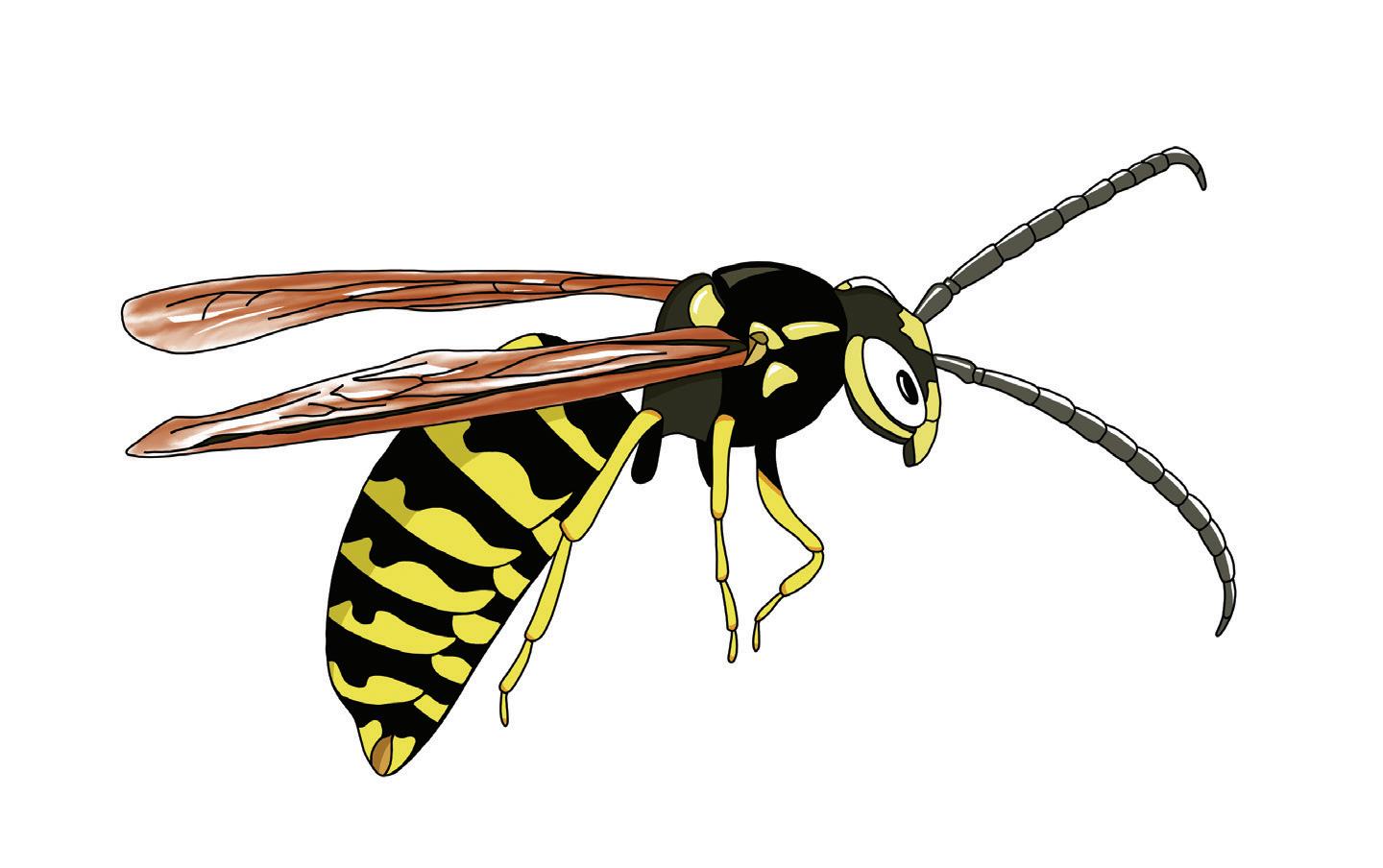
2. It is estimated that a honey bee’s wings can last for a maximum of 500 miles. As they wear out with age, they lose maneuverability.

3. Wasps are pollinators, too. They do not perform this job as efficiently as bees, however, due to their relative lack of hair for pollen to cling to.
4. Bees and wasps belong to the same taxonomic order, the Hymenoptera. Millions of years ago, bees adopted a vegetarian diet, whereas wasps remained omnivores.
5. Cicada killer wasp larvae develop underground, and time their emergence to coincide with the emergence of annual cicadas. The cicada is not much smaller than the wasp itself, but, after paralyzing these enormous insects with their powerful sting, the wasps manage to carry and drag them back to their underground nests, where they lay eggs on the insect’s still-living body. The eggs then hatch and consume the cicada alive.
the topmost branch she’d been aiming for and landed in a cloud of reddish-gold pollen. “So much for the element of surprise,” she muttered, dusting herself down.
Angry voices rose up from below, and she knew that running or hiding would be pointless. Azalea stood proudly, refusing to be cowed, as the glistening3 black and yellow bodies of the dreaded enemy came into view. To her surprise, her first close-up of these “monsters” didn’t terrify her the way she’d expected: If anything they just looked really, really familiar. Sure, they looked kind of dangerous, all points and sharp edges, but they weren’t so different4 from her and her sisters, she thought. Regardless, Az was aware of their fearsome reputation: She believed they would kill her for this trespass, so she assumed a defensive stance and prepared for the worst.
“So it’s a fight you want?” One of the wasps spoke, mistaking her defensiveness for aggression. “We would have let you off with a warning.”
“Sure you would,” Az spat defiantly. “Let’s get this over with.” The wasps tensed, ready to fend off this invader into their territory, when a sudden shadow descended over them. Bee and wasps alike ducked for cover under the nearest leaves, sure that a bird had come to pick them off.
What Az saw when she dared to peek out, however, was no bird. Just like the wasps, it resembled … her, but bigger, so much bigger. Beneath its huge body, in titanic claws, it clasped a green insect just a fraction smaller than itself. How it could carry such a load, Az


 by Peter Keilty, with illustrations by Bridget White
by Peter Keilty, with illustrations by Bridget White
could not imagine. “It’s not our fault, cousin, she was in our tree!” Stuttered one of the paper wasps. The, giant cicada killer wasp5 set its cargo down with a thud and spoke in a booming voice, full of wisdom and authority.

“ Your tree, cousin wasp? I don’t see your name on it!” Az couldn’t help but giggle. “And as for you, cousin bee.” Azalea’s chuckle died in her throat, the creature’s huge, orange eyes rooting her to the spot. “Are there so few flowers in the meadows and woods that you needed to come here, risking open war with the wasps? More importantly, you are kin. Family. We are kin. Distant relatives, I’ll grant you, but tell me: What do you see when you look at each other, or at me? I see six legs, four wings and some dashing stripes. We have more similarities than we have dif-
ferences, and I’ll have no more nonsense out of you.”
Both sides were humbled by the enormous creature’s words. The wasps were the first to break the silence: “Well,” one began, “I suppose you’re just trying to feed your sisters, the same way we do. It’s selfish of us to hoard this tree’s pollen. There’s enough to go around.”
“I wish it were to feed my sisters,” Az replied. “This is all about nothing more than the greed of a wicked queen.”
The wasps conferred among themselves for a moment, before turning to Azalea with a mischievous look. “Cousin bee, how would you like to get even with this queen of yours?” Az smiled. She was starting to like these guys.
A short flight later, they sat perched on the petals of a brilliant-blue flower on the edge of a bubbling creek. The wasps carefully pasted a sparkling, azure pollen onto Az’s hind leg baskets, chuckling as they worked. “This will be a memorable meal for her, cousin bee!” snickered one of them.
“This won’t hurt her, will it?” Asked Az. “She’s the worst, but hurting people isn’t my style.”
“As I think we explained, we aren’t monsters!” the wasp replied with a grin. “But I have a feeling this will make your Wisteria problem a little more bearable.”
Next month: Find out if Dahlia can rally her sisters to save the colony from a deadly ant attack.

The hive was in chaos. Like a creek that lies dusty and dry, only to be transformed into a raging flood when the rain comes, a torrent of ants swept past the colony’s guard bees1 and through the gates. They had one goal in mind: to steal the colony’s egg supply and, with it, its future.2
“The fight is that way, you cowards!” screamed Dahlia, her frustration with Wisteria’s cronies having reached boiling point. She desperately marshaled every bee who would listen to the front of the hive, where the fighting was thick
over and around their defenses, and toward the vulnerable brood.
“I deserve a spa day after this, Dahlia!” shouted her brave sibling, still playing the fool in the face of mortal danger. Wickedly sharp jaws snapped at his face, missing by a hair as he used his bulk to push back the ants.3
“Just hold on, brother! I have a plan.” Dahlia activated her wings and zoomed between the hanging honeycombs, using the skills Az had taught her to navigate the confines of the hive at speed. She allowed herself a split second of hope for her warrior sister, who was no doubt facing her own peril out in the wild. Snapping back to the present, she braced herself and headed straight for the hive’s gates — gates which were entirely blocked by swarming ants. At the last moment she retracted her wings and pulled her legs close to her body — a black and yellow missile streaking toward its target. Dahlia burst through the mass of ants, scattering them like bowling pins. It was one of the bravest things she’d ever done, but the ants hardly noticed.
Outside, the ant army scaled the legs of the hive with relentless determination, those who had been scattered to the ground simply returning to business as usual. They had looted beehives before, and knew how this would end.
1 Ten to twenty guard bees usually patrol the hive’s entrance, on the lookout for “robber” honey bees from other colonies, predatory insects like ants and wasps, animals like mice seeking to shelter in the warmth of the hive, and larger mammals like skunks, bears and humans seeking the honey or protein-rich larvae.

2 Although a honey bee queen can lay up to 2000 eggs per day, when hungry ants are stealing them as fast as she can lay them, the bee colony eventually weakens to the point that they decide to “abscond” to desert the hive and find a new place to live.
3 Although honey bees are larger than ants, they lack the ants’ powerful bite.
4 Honey bees are not normally vulnerable to ant invasions, except in the case of a new colony with a small population, or a colony weakened or demoralized due to a poor-quality queen.
5 Like honey bees, worker ants are all female. Bees and ants are in the same “order” of insects, the hymenoptera.
6 Ants use pheromones to guide one another from their nest to a food source, and back again.
7 Green anole lizards will sometimes eat bees, but much prefer smaller prey like ants, termites and flies.
The bees would put up a good fight, of course, but the ants’ sheer numbers often prevailed.4 They thought as one, with one simple command — “Onward!” — echoing through their collective consciousness. Ant #3564782 reached the entrance, her5 sisters packed in tight around her, scrambling over each other in their eagerness to complete their mission. Irresistible chemicals6 drifted through the air, leading them to the rich food source their colony so desperately needed. She was almost through the breach when suddenly the scent on the air changed. It smelled like … fear, but that was ridiculous. Honey bees were no match for them!
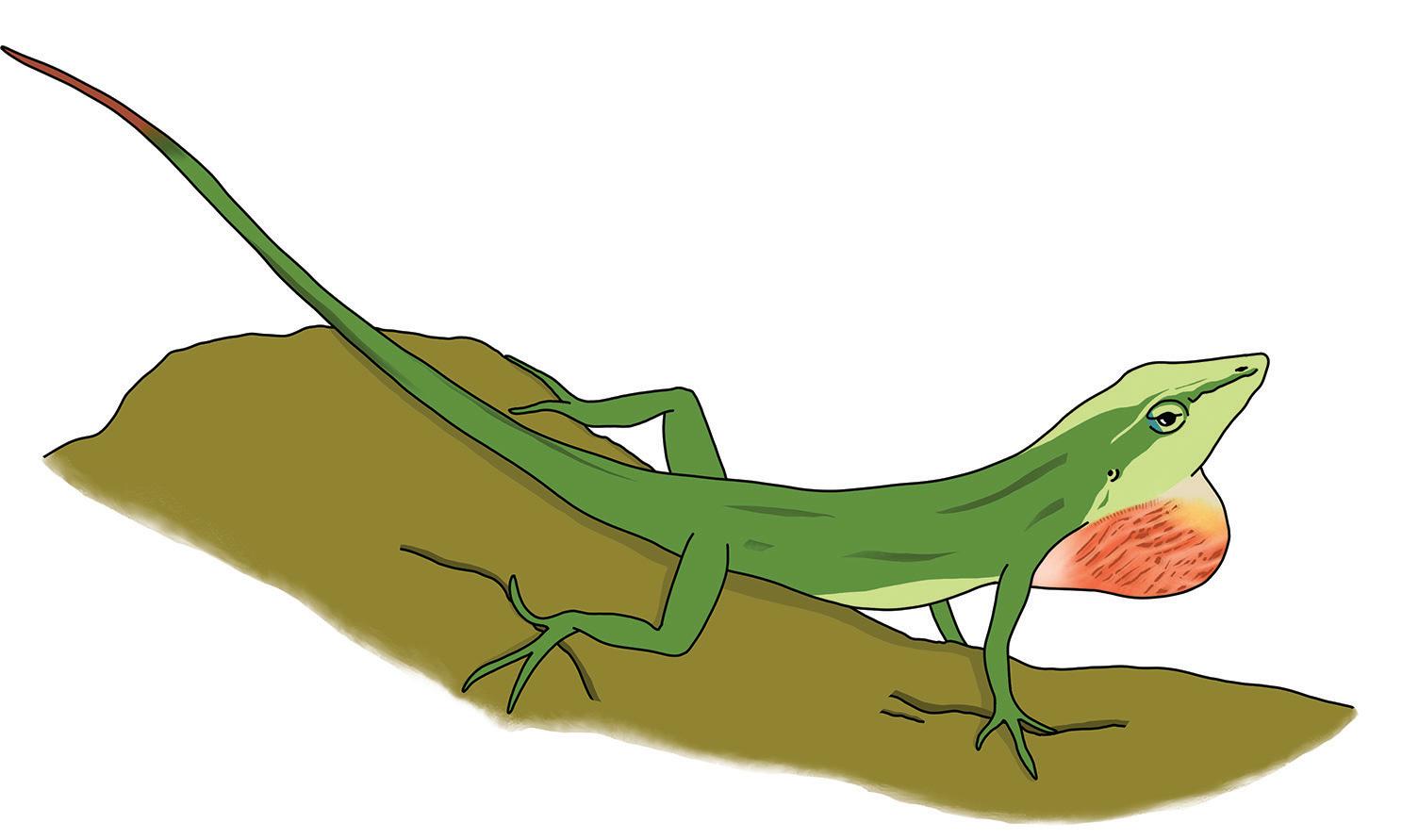
 by Peter Keilty, with illustrations by Bridget White
by Peter Keilty, with illustrations by Bridget White
Circling high above the chaos, Dahlia watched as a lizard lapped up ants by the hundred, its glistening pink tongue sticking to them like glue. It had tried to do the same to her a few minutes ago, but she’d told it to follow her and she’d show it the location of a much more satisfying meal.7 Now it contently perched by the hive’s gates, vacuuming up her enemies with relish.
“But not fast enough,” muttered Dahlia. Hundreds of ants were still making it through. She was grateful they had not yet found the secret entrance at the back of the hive that she and her sisters sometimes used, just a small crack in the wood that had grown bigger over time. “That’s it!” she yelled. Careful not to draw notice to this
secret gateway, Dahlia squeezed through and began assembling a swarm of her own.
Back in the thick of the battle, Narcissus still fought bravely, but even his huge muscles were beginning to tire. As he started to lose hope, the roof of his home lifted off and blinding sunlight streamed in. Ants and bees alike both looked to the sky, stunned by the sudden change. A huge white spider, bigger than anything the drone bee had ever seen, descended from the sky toward him. “I must be dreaming,” he mumbled, as exhaustion overcame him and he lost consciousness.
He awoke to blackness. “Hmm,” he remarked to himself. “So this is what being dead feels like. It’s not so bad, really. Kind of smells like the salon, actually. That’s weird. Wait, is someone trimming my nails?” He wiped his eyes clear, and light streamed in. “Cucumber slices?”
“You’re not dead, you dope. Although for you, this is pretty much Heaven.”
“Dahlia!” He clasped his sister in a bear hug, overjoyed to still be in the land of the living. “But that spider, what … how …?”
“That was a human’s hand, brother. We created a swarm so large that the Keeper had to come and check on us. Turns out, he doesn’t like ants too much!”

“He’s not so bad. He even left you this.” Dahlia handed the brave hero a goblet of sugar syrup, still cool from whatever magic the beekeeper, or “Keeper” as they called him, used to perform such wonders.
“Cheers to that, sister,” he said, replacing the cooling cucumber slices on his eyes. “Cheers. To. That.”
Peter Keilty is a beekeeper and pollinator conservationist living in Austin, Texas. His focus is on beekeeping as a means of educating and spreading awareness regarding the plight of pollinators, and native bees in particular. Beesforall.com/@beesforall

Bridget White serves as the Youth Encouragement and Public Education Chair for the Entomological Society of Manitoba, and strongly believes in using her talent for art to educate and inspire others on the value and wonder of insects. @bri.bugs

Queen Wisteria paused between bites. “What was I saying, again?” she asked, dabbing crumbs of the coveted wasp tree pollen from her mandibles. Dahlia and Azalea exchanged amused glances, while Narcissus stifled a giggle as best he could. It was the third time the Queen had lost her train of thought, and the punishments she had dished out were long forgotten.
“That must be powerful stuff,” whispered Dahlia to her elder sister. “It’s affecting her memory in more ways than one.” The Queen resumed her snacking, having already forgotten her question about forgetfulness.
“Why are you three just standing there? Can’t you see I’m eating?” said the Queen impatiently.
“Your Majesty, you sent us to fetch them here,” explained one of her advisors.
1 While bees do not possess a sense of smell the way we humans think of it, they use their antennae to detect floral chemicals in the air.
2 Both bumble bees and honey bees can detect the weak electrostatic charge given off by flowers. The bees are positively charged, while the flowers have a negative charge. The antennae and small hairs along the body allow the bees to detect this electric field, and to quickly determine which flowers have been visited and which have not. It is thought that flowers with a change in electrical charge have already been visited by another pollinator, and the bee will quickly move on.
3 Different species of butterflies lay their eggs on specific “larval host” plants. The eggs mature into caterpillars which then feed on the plants’ leaves. This is one more important reason to have a diverse garden with many different wildflower species.
4 These are syrphids, also known as “hover flies.” Some species have evolved the black and yellow “warning” colors of bees and wasps, to deter predators. They lack stingers and are harmless, however. You can spot them in your garden by their big eyes, two wings rather than the four wings of bees and wasps, and their tendency to hover in place.
5 Wasps contribute to a healthy ecosystem (and garden!) by controlling aphids.
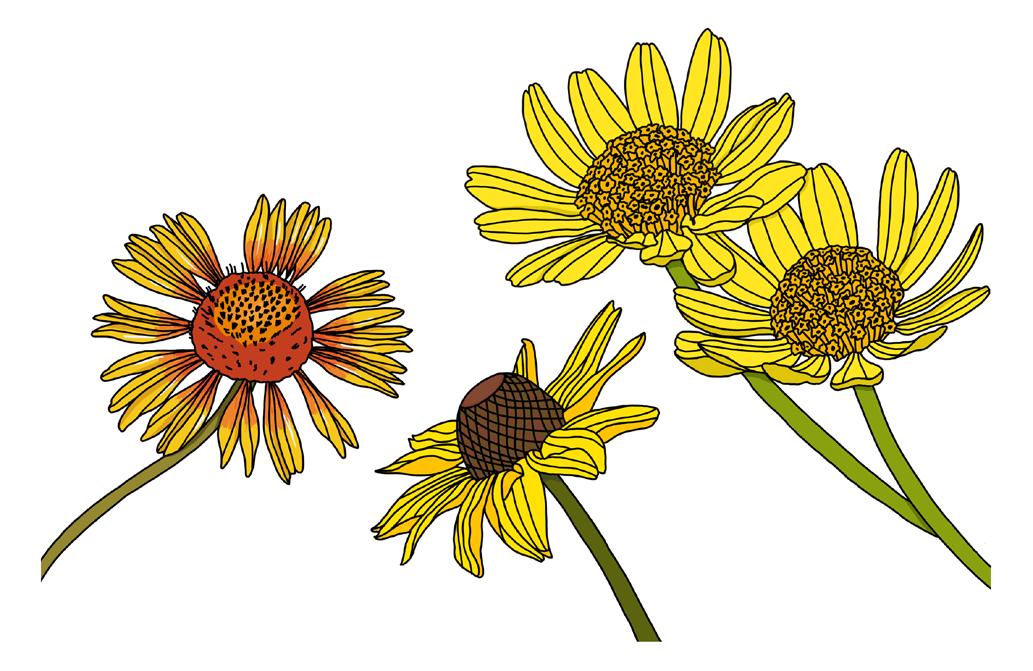
6 Assassin bugs lie in ambush on flowers. They immobilize their prey with a paralyzing toxin.
7 Bumble bees, once known as “humble bees” and even “dumbledores” (for all you fans of a certain young wizard) are a social species whose underground colonies usually number between 50 and 400 individuals. Like honey bees, they store pollen and honey to raise their young, but in much smaller amounts. Many species make their nests underground in abandoned rodent burrows.
8 Seventy percent of the world’s bee species make their nests underground.

“Don’t talk nonsense,” snapped Wisteria, as she offered her courtiers some crumbs in a rare gesture of generosity. “You have got to try this! It’s delicious.” Her attendants sheepishly sampled the exotic pollen, fearful of offending the matriarch. In no time at all, they were as absentminded as their leader. Dahlia and the others took this as their chance to slip quietly away, waiting until they were at a safe distance to let out a whoop of joy. The trio of friends had their regular duties back, and they were determined to make the most of it.
Dahlia and Az parted ways with their brother at the gate, the female bees eager to return to foraging. As they took to the sky, what few worries they had evaporated in the joy of being alive. Floral scents drifted on the air, the sisters’ antennae1 twitching this way and that in search of the richest source of food. A heady blend of aromas was drifting in from the east, and the sisters
headed in the direction of the morning sun. The vibrant colors of a meadow soon came into focus. Although it was teeming with blooms, the sisters’ hearts sank: They may have arrived at the buffet too late. Hundreds of hungry diners were already tucking in to the flowery feast patrons of all shapes, colors and sizes. “They’re picking this field clean!” shouted the elder bee. “Let’s get down there and salvage what we can.”
Dahlia watched the more experienced bee work. It was a masterclass in efficient foodgathering. Sometimes Az would land on what
 by Peter Keilty, with illustrations by Bridget White
by Peter Keilty, with illustrations by Bridget White
looked like a perfectly good flower, only to wrinkle her nose and quickly move on, rejecting it completely. Was her sister really that picky? Azalea caught Dahlia’s mystified glance. “You don’t feel it, sister? That little tingle2 you get when you land on a good flower?” Az was right. Dahlia could feel it. What a neat trick to learn.
Flowers worth visiting were few and far between, however. The sunny meadow was awash with butterflies, their gigantic wings catching the wind like the sails of a ship. She watched, spellbound, as the sunlight filtered through the wings of a large black and orange species, its long, coiled tongue unfurling to reach the nectar deep inside a tubular flower. To Dahlia’s surprise, however, most of the butterflies were not there to enjoy the feast. Many were laying their eggs on the undersides of the plants’ leaves,3 as were some curious little creatures that looked very like Dahlia, but with huge eyes and a very different manner of flight.4
On the journey over, Azalea had described her adventures at the wasp tree, and Dahlia could see many wasps here too, enjoying the bounty of nectar as much as everyone else. She caught a glimpse of their fierce side, too, as one of the wasps prowled in search of prey, snapping up a plump, green aphid5 in its powerful mandibles. Caught up in the fascinating dramas unfolding around her, Dahlia dropped her guard for a moment, and a wickedly barbed claw6 shot out to grab her. She veered away at the last moment, and her ambusher got nothing more than a tuft of her hair. Rattled by this near escape, Dahlia retreated to the edge of the meadow and alighted on an unoccupied flower to catch her breath.
Her solitude was short-lived, however: A huge, fluffy bumble bee landed next to her and, with a polite “good morning” began lapping nectar.
“You have quite a thirst,” said Dahlia, making small talk. “If I didn’t know better I’d think you were going to make honey with that!”
“Oh we love making honey, actually,” replied the bumble bee in its deep, baritone voice. “We just don’t make as much as you do. Look,
down there, that’s my home.”7 All Dahlia saw was a small hole in the ground, un til another bumble bee clambered out of the entrance and took flight. “A mouse fam ily used to live there, you know, but they left and we moved in. It’s very cozy!” As she looked at the ground below, Dahlia saw yet more bees emerging from underground homes: Some were round and fluffy like her new friend, others were jet black and shiny, and many looked almost like her.8
Her new friend was very talkative, and Dahlia enjoyed listening to her describe her unusual way of life. It was when the bumble bee’s chatter stopped abruptly, however, that Dahlia’s instinct for danger kicked in. The bumble bee froze, staring over Dahlia’s shoulder in openmouthed terror, before both bees instinctively took flight to avoid whatever was rapidly heading their way. Whatever it was, it missed them by a hair’s breadth, the rush of air as it whooshed by sending the bees tumbling head over tail. Before she had a chance to right herself, Dahlia felt the reassuring hand of her sister dragging her away. “Never a dull moment, eh sister?!” laughed the elder bee, despite the danger. “That thing is hot on our tail. Just follow me and do not look back!”
Peter Keilty is a beekeeper and pollinator conservationist living in Austin, Texas. His focus is on beekeeping as a means of educating and spreading awareness regarding the plight of pollinators, and native bees in particular. Beesforall.com/@beesforall

Bridget White serves as the Youth Encouragement and Public Education Chair for the Entomological Society of Manitoba, and strongly believes in using her talent for art to educate and inspire others on the value and wonder of insects. @bri.bugs
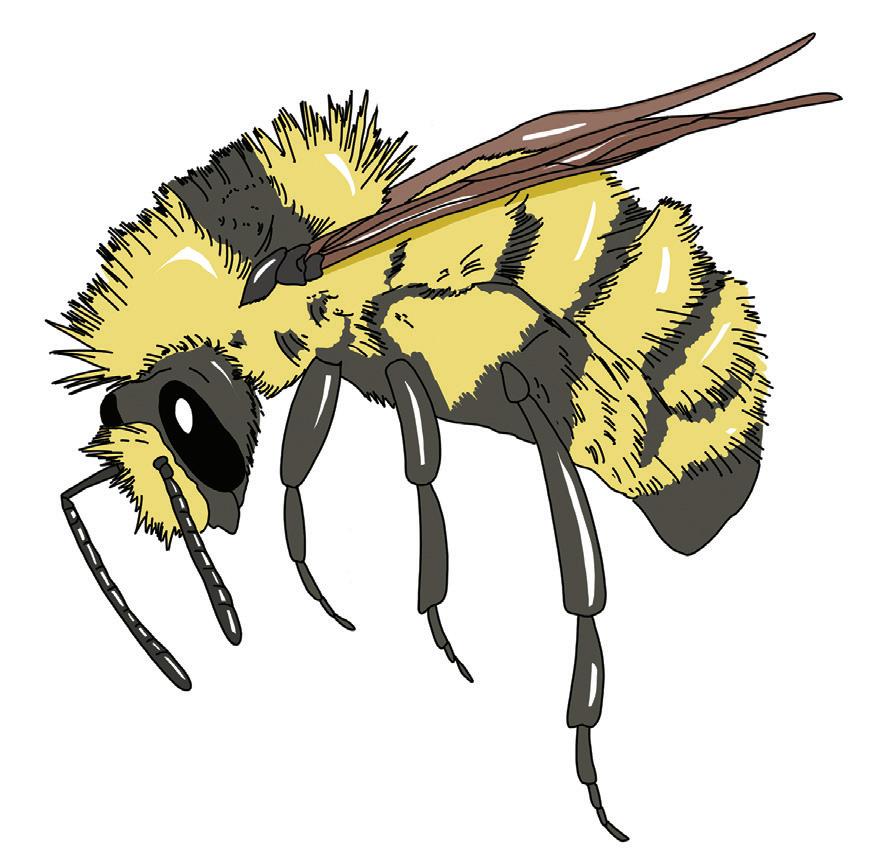

It was big. It was fast. And it was hot on their tails. Dahlia chanced a quick look over her shoulder, but all she could make out was an angry, red blur of feathers and talons.1 The squawking and snapping was getting louder by the second — she was moments from becoming bird food, and she knew it.
Azalea led the escape, darting into the woods in the hope of throwing their pursuer off the trail. They zipped from the forest floor high into the canopy and back again, zigging and zagging as they went. Az even led them dangerously low across a beaver pond,2 weaving through clouds of formidable dragonflies whose bodies gleamed like precious gems. It was no use, though: Their every wing beat was matched by the bird, and Dahlia knew it would take something desperate to tip the scales in their favor.
1 The summer tanager (Piranga rubra), nicknamed the “bee bird,” is bright red and has been described as looking like a cardinal without a crest. It has a fondness for bees and, although disliked by beekeepers, does not deplete honey bee populations as bees are only one item in their varied diet. They also feed on wasps, grasshoppers, spiders, flies, cicadas, beetles, caterpillars and, at times, fruit. No species of bird in the U.S. eats only bees.
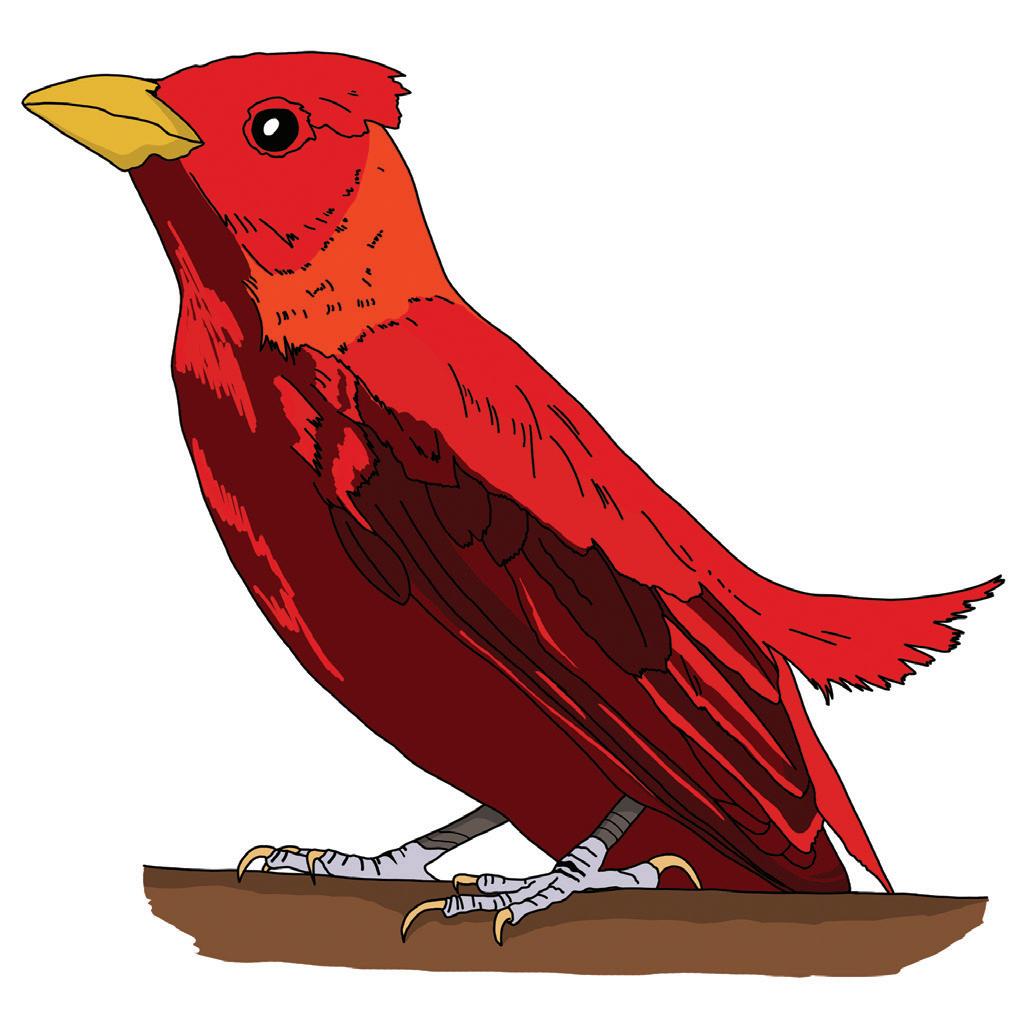
2. A beaver’s dam-building can turn a fast-moving stream into a series of shallow pools, ideal for the life cycle of insects such as the bee-eating dragonfly.
3. The Joro spider is an introduced species from Asia that is quickly spreading through the eastern portion of the United States. They are very large and strikingly colored, and spin large webs that can be a nuisance to humans. However, University of Georgia scientists say that they have not observed any detrimental effects on native species and that they are an effective pest control on mosquitoes and other biting insects.
4. Though still living, some old trees are heavily decayed and have multiple cavities that can be used for nesting and denning by wild animals. Other creatures feed on the decaying wood and are preyed upon in turn.
5. Owls are nocturnal (nighttime) hunters.
6. From the ancient Greek, and literally meaning at the entrance to (“pro”) the community or city (“polis”), this sticky substance is used in hive defense.
7. A honey bee’s ideal nest in the wild, according to Professor Thomas Seeley, is a cavity high in a tree, facing south, with a single entrance hole.
8. A colony will tolerate the occasional bee returning to the wrong hive, but will react defensively to aggressive bees from rival colonies, arriving in greater numbers in an attempt to “rob” honey.

“Az!” she shouted into the wind. “I think I’m ready.”
“For what?!” yelled the elder bee, struggling to coax out every last drop of speed from her tattered wings. “Dahlia, this really isn’t the time …”
“To graduate Flight School, Az. Let me show you what I can do.” Az nodded and allowed her sister to take the lead for the first time, hoping that her belief in the young bee was not misplaced. Dahlia pitched them into a dive almost immediately, whizzing through the trees in search of something that would provide an advantage. Up ahead, Az could see what Dahlia was leading her to and, for a split second, the elder sister considered putting her wings in reverse and confronting the bird instead!
“No. Nope. Not doing it, sister!” Before them gleamed a silver web, strung between two branches and, in the middle, the largest, scariest spider the veteran bee had ever seen.3 “That spider makes the last one look like a puppy dog, Dahlia! Are you trying to give me a heart attack? You know my history with those things.”
“I’m sorry, sister, but this might be the only way. There’s a gap in the web that I think we can squeeze through, but we have to make this believable.” Slowing just a fraction, they allowed the bird to get tantalizingly close — it was focused on filling its belly and didn’t see the danger ahead.
 by Peter Keilty, with illustrations by Bridget White
by Peter Keilty, with illustrations by Bridget White
“Now, Az!” As one, the bees dipped low and slotted through the gap while, behind them, a cacophony of screeching and flapping erupted.
“Az, I think we … oh no.” Dahlia’s celebration curdled in her mouth as the bird tore through the web and emerged victorious, the bright green spider clamped firmly in its beak. “All I did was feed it!”
“Maybe it will be less hungry now, and only eat one of us,” joked her sister. The look Dahlia shot back at her suggested that now was not the time.
“Leave the Dad jokes to Narcissus, please.” Dahlia scanned around desperately for an other trick she could play, or even a place to hide. Az had put her faith in Dahlia, and the young bee was determined to prove herself al most as much as she was determined to save their lives. “Az, look down there!” She pointed toward a mother fox carrying an unruly cub back to their den, nestled in the base of a huge, decaying tree.
“Very cute, Dahlia, but I’m a little more fo cused on our imminent doom right now.” It took only a moment for her sister’s point to sink in, however: Hollow, old trees are home to more than foxes.4 As they climbed, the sisters saw a woodpecker busily excavating a nest from the soft wood, and an owl safely waiting out the daylight hours5 in a snug little nest of her own. When they had almost reached the top of the tree, Dahlia thought she could make out the faintest scent of propolis6 and then, yes, there it was! A steady flow of honey bees making its way in and out of a tiny hole7 — the sisters had found a wild colony, and it was their last hope. They landed just inside the entrance, and their pursuer veered away sharply, having decided that the snack wasn’t worth taking on an entire colony. Az and Dahlia exchanged a relieved glance, still panting from the exertion.
“Just the two of you is it? Not here to make trouble,8 I hope,” said a formidable guard bee standing watch at the hive’s entrance. ”You were lucky — I’ve lost many sisters and brothers to that scarlet menace. Come on, you’ll need to get formal permission to stay, from the Queen.” She led them through the hive, a place similar and
yet so different to their own home, until they reached the Queen’s chamber. “Now, mind your manners, you two,” barked the gruff guard as she swung open the heavy doors. “This is royalty you’re dealing with.” Dahlia and her sister weren’t listening, however. They were rooted to the spot in shock.
“Mother?!” they gasped.
Peter Keilty is a beekeeper and pollinator conservationist living in Austin, Texas. His focus is on beekeeping as a means of educating and spreading awareness regarding the plight of pollinators, and native bees in particular. Beesforall.com/@beesforall

Bridget White serves as the Youth Encouragement and Public Education Chair for the Entomological Society of Manitoba, and strongly believes in using her talent for art to educate and inspire others on the value and wonder of insects. @bri.bugs
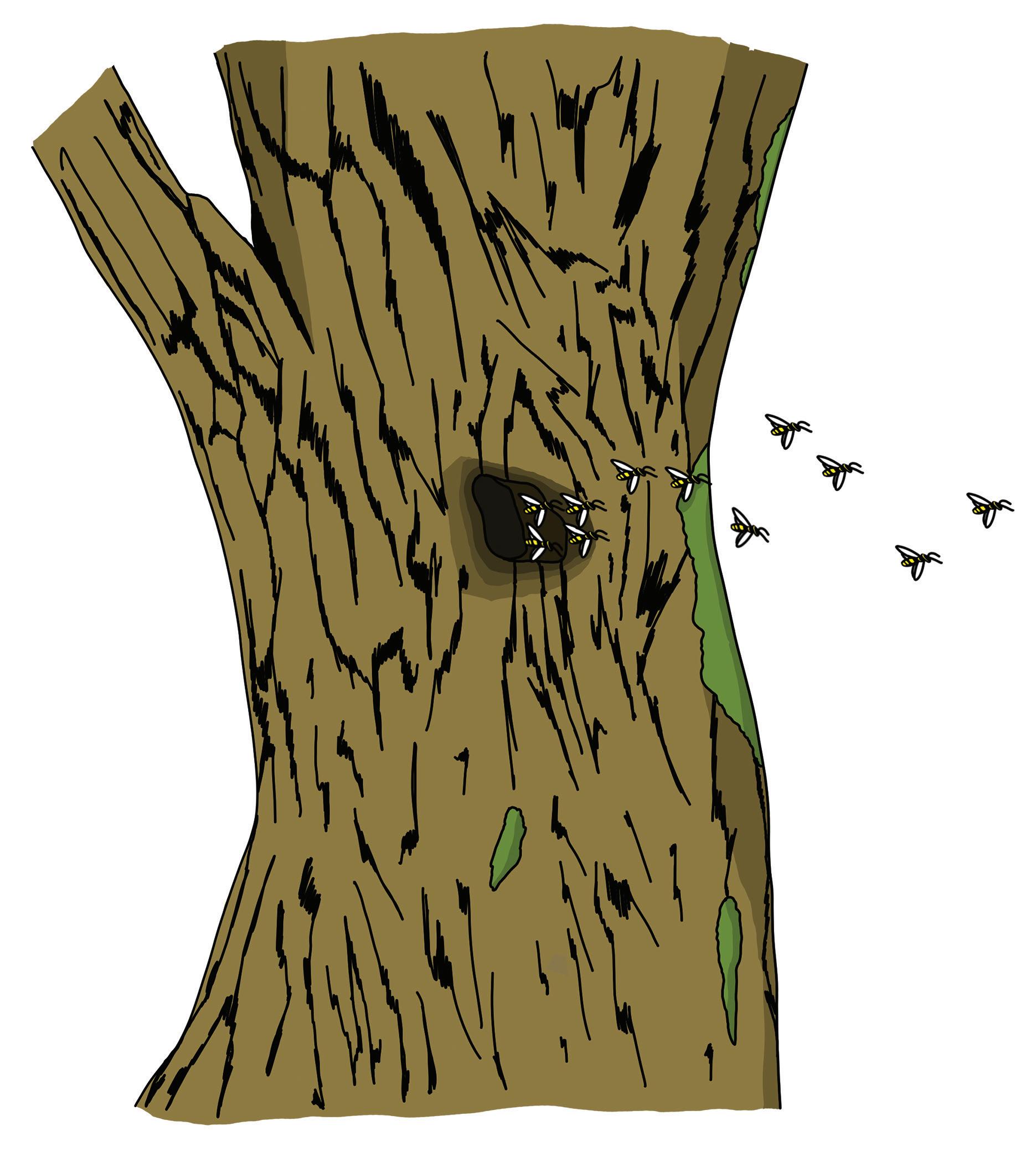

“No, not Mother, but I appreciate the compliment. She was a beautiful bee.” Was. The word hit Dahlia like a hammer blow. Queen Daphne was gone and, to the sisters, it felt like losing her all over again.1 “What happened?” croaked Azalea, fighting back tears.
The new Queen looked at them in sympathy, feeling their pain keenly. “She was simply old, sisters. But look at what she accomplished while she still drew breath!” The monarch gestured to their surroundings, a towering cavern whose fragrant walls glistened in the half-light. “My mother, our mother, founded this colony and made it strong and independent. And when my sisters
1. When a colony swarms, it sends away its old queen while the new queen it has raised remains in the hive. Queen Daphne had left Dahlia and Az’s hive in this way.
2. A colony senses when a queen is old or weak, through her weaker pheromones. To save the colony she must be replaced.
3. More than one queen can exist inside a hive at one time, but only for a short period.


4. Baby bees.
5. According to Professor Thomas Seeley, feral honey bees prefer their nest entrance to be located at the bottom of the cavity because of its effect on air flow and water condensation. The ability to harvest water from the hive walls is particularly important in winter when outside water sources may be frozen, and leaving the hive is hazardous for the bees.
6. A bee exposed to pesticides outside the hive can bring some of the chemicals back on her body, potentially harming others within the hive.
7. Some pesticides affect the central nervous system of honey bees. They can affect navigation, learning and even taste sensitivity.
suggested, after she had poured all her strength into it, that perhaps we should raise a new Queen,2 she accepted with grace and dignity. I was privileged to know her for a few, precious days3 before she passed.” She removed her crown, placing it on a purple cushion beside the throne. “I am Queen Betony, but I would prefer it if you called me
‘sister.’” She took Dahlia and Az by the hand and they shared a moment of silence for the departed monarch.
Dahlia wiped away a tear, her sadness replaced for the moment by wonder and curiosity at her new environment. “Quee … sister , your home is amazing.”
“I concur, sister,” agreed Queen Betony. “Come, let me give you two the royal tour.” Still holding hands, the bees rose through the cavernous hive, the soft hum of their wings barely audible over all the activity going on around them. Four huge combs hung from the ceiling, every cell seemingly filled with

 by Peter Keilty, with illustrations by Bridget White
by Peter Keilty, with illustrations by Bridget White
honey or brood,4 being tended to by an army of her distant relatives. The combs were not the small, uniformly shaped combs of Dahlia’s home, but hung from the tree cavity’s ceiling like pendulous stalactites from the roof of a cave. Water cooled and condensed on the walls,5 and the sisters watched the bees gather it and put it to use cooling the hive, amazed by their inventiveness. Dahlia looked at the honey cells with hungry eyes, her escape from the bird having left her weak and depleted. The Queen seemed to read her mind she poked a claw through a capped cell, and thick, dark honey oozed out. She invited the sisters to try for themselves, and the flavor had them both craving more.
Their reverie was bro ken, however, as the sounds of alarm echoed from below. Foragers were returning to the hive, and something wasn’t right. Queen Betony rushed toward the danger, in that way so like her mother, but her attendants held her back as best they could. “Queen,” they begged, “what if it’s like last time? Please stay away until we assess this threat.” The monarch reluctantly agreed, but Dahlia and Az couldn’t resist investigating.
They could see that the other bees were keeping their distance 6 from the newly-returned foragers, rather than greeting them and helping to offload their cargo of nectar, pollen and propolis. What could cause sisters to shun one another, Dahlia wondered, but
then she noticed the erratic behavior of those who had returned. They staggered 7 as if drunk, like that time Az had caught Narcissus dipping into a pot of honey that had fermented by accident. But there was nothing funny about the scene unfolding in front of them.
The foragers staggered in circles, confused and lost, sometimes falling over before weakly pushing themselves to their feet again. It was the most pitiful sight either bee had ever seen to see such intelligent, hardworking creatures brought so low. “They’ve been poisoned!” whispered Dahlia, trying not to cause more alarm. The Queen alighted beside them, her anger at the
“Poisoned indeed, sister. But from where, or by whom, we have no idea.
future of our colony if this continues.” Dahlia and Az exchanged a glance, and they knew what they had to do. This colony was their Mother’s legacy, and they vowed to get to the bottom of this mystery.
Peter Keilty is a beekeeper and pollinator conservationist living in Austin, Texas. His focus is on beekeeping as a means of educating and spreading awareness regarding the plight of pollinators, and native bees in particular. Beesforall.com/@beesforall

Bridget White serves as the Youth Encouragement and Public Education Chair for the Entomological Society of Manitoba, and strongly believes in using her talent for art to educate and inspire others on the value and wonder of insects. @bri.bugs

They raced from the darkness of the woods, out and across bright fields. A riot of colors was laid out across the land like a patchwork quilt, and the sun hung low in the sky a warning to the sisters that they should seek the safety of home before nightfall.1 But they still had a job to do. As eager as they were to trace the culprit who’d harmed their cousins, they also feared what they might find. Dahlia would never forget the sickly smell that clung to those poor bees and, as they flew toward the setting sun, she caught just a hint of that same odor, drift ing on the breeze. “It’s coming from over there!” Dahl ia pointed to a bright yellow field in the distance. “But how do we get closer without getting sick?”
1 Honey bees return to the hive each night for safety, warmth and sleep. Mature, forager bees sleep longer than their younger, house-bound sisters.
2 While we mostly think of honey bees’ hair as a way for them to transport pollen, the hairs are also used to keep warm and to sense vibrations.
3 Bumble bees have a dense covering of hair, and are able to forage on days that are too cold for honey bees.
4 This is called a “monoculture.”
5 Some farmers now use drones for pesticide application. It is argued that their precision, compared to airplanes or tractors, can reduce overall chemical use. But spraying insecticides during the day, on crops in bloom, can be deadly to pollinators no matter how it’s done.
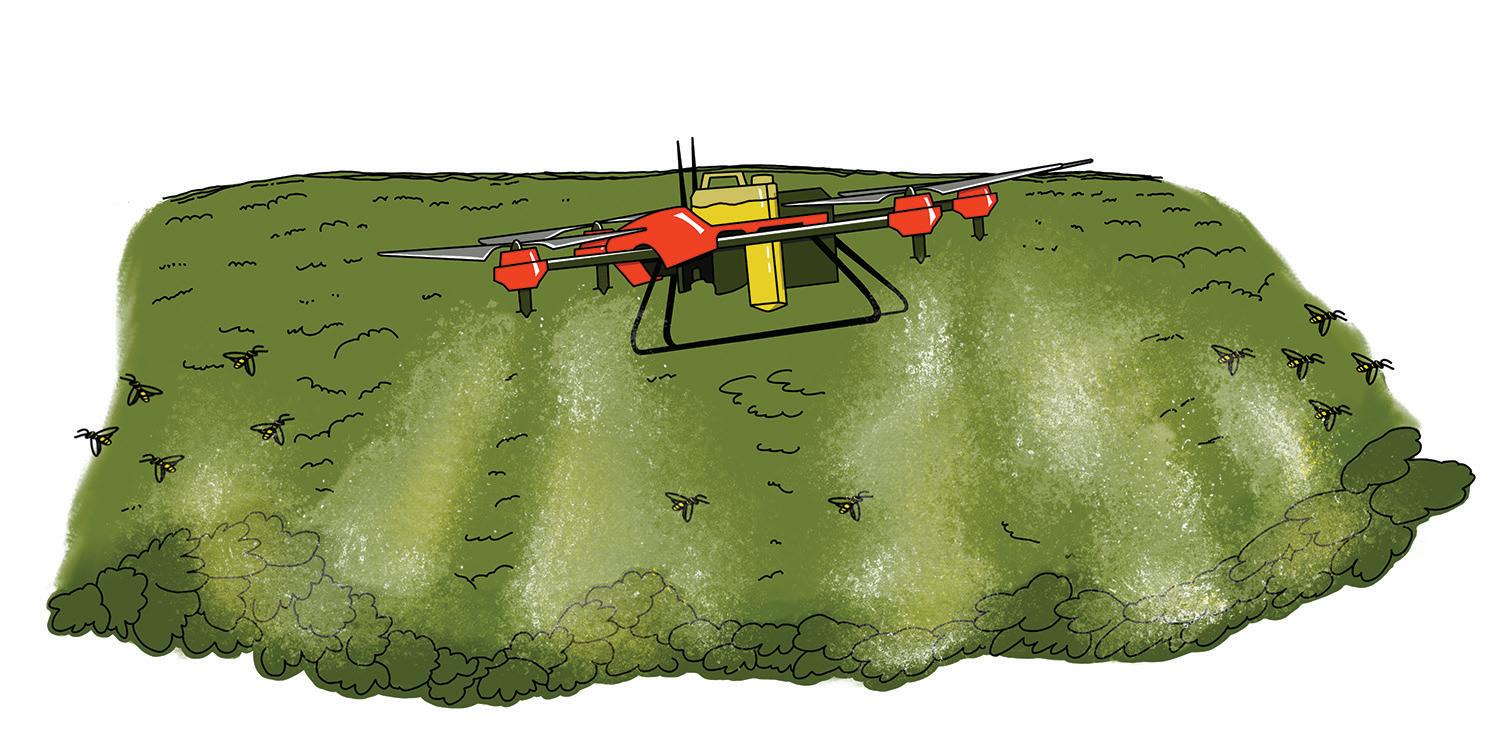
6 Although pesticides are used to control insects that damage crops, pollinators are harmed as an unintended consequence.
7 A monarch butterfly, which migrates all the way from Mexico to the northeastern United States.
8 Pesticides can “drift” to unintended areas.
9 This behavior is called “bearding.” Honey bees use it on hot evenings to lower the temperature and humidity inside the hive. At night time, most of the bees will move back inside the hive. When bees are swarming, they will also perform “bearding,” but this will be accompanied by increased aerial activity outside the hive.

10 Honey bees will abandon a hive that has become unlivable. This can be from damage to the hive itself, pest infestation or pesticide exposure.
Azalea had learned a thing or two from her mission to the Wasp Tree, and she treated Dahlia to a crash course in high-altitude flying. The younger bee shivered in the cold air, glad for her covering of hair,2 and suddenly envious of every bumble bee she had ever met.3 Dahlia had never seen the land organized so neatly before: Unlike the multicolored meadows she was used to, these fields were blocks of solid color, with only one type of plant in each.4 Far below, as tiny as a child’s toy, a farmer’s tractor harvested neat rows of his crops, like drawing dark lines on a colored page. The effect was hypnotic, and Dahlia almost forgot about the danger that lay ahead.
The field they sought was now directly below, its expanse of yellow flowers transformed into a deep gold by the angle of the setting sun.
Azalea was taking no chances, and advised they hover in place until they could gather more information. It was dead quiet and, for a moment, they began to doubt themselves. The sisters flinched as, all of a sudden, a bright red object flew across the field, followed by more. At first they thought it must be the scarlet bird that had pursued them, back to finish what it had started, and with backup this time. But these were not birds, and there were so many of them, zipping this way and that. The sisters descended as low as they dared, and what they saw was shocking: A swarm of flying machines, 5 spraying gallons of poison over the field, regardless of what was in their way. 6 Azalea gasped as a beautiful butterfly dropped from the sky, its orange and black wings 7 flapping uselessly as it struggled to cling to life. From bees to beetles and everything in between the poison spelled doom to all it touched.

 by Peter Keilty, with illustrations by Bridget White
by Peter Keilty, with illustrations by Bridget White
Dahlia felt utterly useless in the face of such destruction. She wanted to help, but knew that to venture closer would mean death for her, too. She watched helplessly as the cloud of poison drifted in the wind, toward a tiny meadow, into which the insects had fled for safety. Nowhere was safe, it seemed.8 “Nowhere …,” she thought out loud. Azalea sensed her sister was on to something. “Az, you know every inch of this countryside. Are there any of these fields,” she swallowed hard, “near our home?” The color drained from the elder bee’s face and, without saying a word, she raced off in the direction of their hive. “I’ll take that as a ‘yes,’” shouted Dahlia, into the wind.
Something was wrong. Something was very, very wrong. They could see their hive in the distance, and the Keeper running around like a headless chicken. He looked different — gone was his usual white suit, and she could see his face for the first time. How odd he looked, thought Dahlia. His long beard looked just like the shape she and her sisters made when they clustered outside the hive on a hot, humid night.9 Dahlia again caught the sickly scent of poison, as the breeze carried it toward her home, and her
family. She nodded toward Az the two took a deep breath, tucked their wings, and headed into the fray.
They weaved through a thick cloud of their sisters, angrily circling in front of the hive. The rest clung to the outside of the hive in a thick mass, each bee carrying as many of their possessions as they could. Dahlia and Az pushed through the crowd and into the hive, as the last few brothers and sisters hurriedly made their way to the gate. One bee was lagging behind, however. They watched as Narcissus, the last to leave, struggled with his many treasured items but, for once, Dahlia had no jokes to make. His grunts and groans echoed through the eerily empty chamber,10 a sight she had never witnessed before, and never wanted to again. “Sisters,” panted Narcissus. “Pack your bags. We are out of here!”
Peter
is

Bridget White serves as the Youth Encouragement and Public Education Chair for the Entomological Society of Manitoba, and strongly believes in using her talent for art to educate and inspire others on the value and wonder of insects. @bri.bugs

Dahlia stood alone and in silence, the commotion outside muffled by the walls of the hive. The place she had called home was a home no more and, even with tens of thousands of her family waiting right outside, she had never felt so lonely. Had her mother felt this way as she began her journey into the wild? No, Dahlia thought that had been a natural part of the colo ny’s life cycle, and Queen Daphne had had a safe, new hive waiting for her.1 The future to Dahlia looked dark, dangerous and uncertain. It was how she’d felt when Az took her across the lake one time, as a shortcut looking down into those dark, murky depths had given her goosebumps, not knowing what dangers lurked within.2
Gathering up her courage, she stepped outside into a cloud of waiting siblings.The poor
1 Before a hive swarms it sends out scout bees to find a suitable nest location. Although beekeepers don’t like swarming, it’s a natural part of honey bee life. Dahlia’s hive, however, is “absconding” due to extreme stress.
2 Dahlia’s fear of the lake was well founded. Trout eat bees and wasps, as well as many other types of insects. Anglers sometimes use honey bees as lures when fishing for trout.
3 A good beekeeper will monitor colonies for signs of disease and parasite infestation, and intervene when necessary.

4 When harvesting honey, a beekeeper will be careful to leave enough to get his colonies through the winter.
5 A cluster is at its warmest in the center and coldest on the outside. The bees switch positions regularly to make sure each gets a chance to warm up.

6 Beekeepers will sometimes try to catch swarms to add to their apiary. The beekeeper gets extra bees and, in return, the bees get a safe home. Finding a safe place to nest in the wild is not guaranteed.
7 Bee swarms are often found in unusual places. Cars and fire hydrants are very common, but swarms have been documented hanging from the wings of parked airplanes (and causing flight delays!) and even on the famous hotdog stands in New York CIty’s Times Square.
8 The scout bees perform a “waggle dance” to communicate the location of proposed hives, which other scouts then decide to accept or reject.
Keeper was just visible through the haze of bees, and seemed to have given up the fight. He sat with his head in his hands and, as bad as Dahlia’s troubles were, she couldn’t help but feel sorry for him. To be honest, she wasn’t exactly sure why he did what he did, giving them a home in that nice little box, but he had always treated them with respect keeping them safe and healthy,3 and always leaving enough honey to get them comfortably through winter.4
Dahlia reluctantly joined the colony as it slowly began to depart. The air was crowded, with lots of bumping and shoving as they clumsily made their way through the dusk. The most experienced foragers like Azalea suggested they wait out the night somewhere safe, away from any lingering poison that may still be drifting on the wind. And so the bees alighted high in an old oak tree, and clustered together to stay warm through the night.5
The first fingers of sunlight were reaching over the horizon next morning, and already the scout bees were awake and vibrating their flight muscles in preparation for a day of househunting. Az made ready to join them, knowing this would be the most important mission of her life, but a commotion from below signaled that the mission would have to wait: another Keeper was dragging a ladder toward their tree.6
“All right, sisters and brothers,” Az hollered over the din, “I know you’re afraid, and I know this is the hardest thing any of you has ever done, but I need us to move.” The bees looked back at her, too tired and afraid to leave their temporary home. “That means NOW, people!” Az boomed, sounding much more confident than she really felt. Her siblings rose into the sky in a hurry and, with the other Keeper halfway up the tree, they again took flight.
 by Peter Keilty, with illustrations by Bridget White
by Peter Keilty, with illustrations by Bridget White
Their journey took them through a small town, and Dahlia couldn’t help but think that this was the most humans she had ever seen. She wondered if they were all Keepers or if, like her colony, everyone had different jobs to do. She got her answer sooner than she expected when the swarm took a rest under a shop’s awning. The shop owner raced out with a broom and shooed them away, almost harming some of the bees in the process. A Keeper would never do that, she thought, as they landed on one of the funny little machines the humans liked to ride around in. Catching her breath, Dahlia told Az that they had bet ter send out scouts straight away, while they did their best to stay out of trouble and away from danger.7
As they huddled for warmth, Dahlia heard voices coming from below. They didn’t sound angry, but it seemed the bees had been discovered, yet again. “No you will not use that newspaper on them, Consta ble Stevens! I happen to love bees,” said a woman’s voice.
“Well how do you propose ...?” A man this time. “Wait, maybe if I hit the lights, that’ll scare them off.”
The swarm was illuminated in flashing red, white and blue lights and, as unusual as it was, the siblings weren’t frightened by it. Even Queen Wisteria, sheltering in the warmest, coziest part of the cluster, popped her head out for a look. “Beautiful, isn’t it, Dahlia?” said Narcissus. “Reminds me of a disco I once went to. Oh that was quite a night, we danced ‘til dawn!” Nothing broke Narcissus’ spirit, thought Dahlia, nor his desire to have a good time whenever possible.
”It’s not working, Stevens. Try the siren a little,” came the woman’s voice again.
“Of all the luck!” Narcissus exclaimed. “Dahlia, of all the places we could have landed, we’re on some kind of weird, mobile disco! It’s like they knew old Narcissus was coming, and rolled out the red carpet.” Dahlia was long past correcting her brother’s flights of fancy so, in-
stead, she watched him start to dance.
“I can’t get these bees to move!” The man’s voice from below sounded increasingly frustrated.

“Au contraire, Sir,” shouted Narcissus. “Watch this!” His enthusiasm was hard to resist and more of the bees joined in, glad to have a moment of fun despite the situation. The party was still raging when the first of the scouts came back, with a life-or-death dance of her own to perform.8 The partying bees backed away, allowing the scout to take to the dance floor. She performed a complex routine, describing the location of a possible new home.
“No, no, no,” shouted Wisteria, over the siren’s wailing. “I am not living underground. Off you go and don’t come back until you’ve found somewhere fit for a queen!” The dejected scout took to the air and Dahlia was, for once, glad of their Queen’s snobbery. Swarms had to make the best of things, she knew, but was it wrong of her to hope for somewhere nice, a place she could truly call “home”? Scout after scout busted their best dance moves on the roof of the patrol car, but the colony couldn’t agree on any of the proposed sites. Finally, an exhausted Azalea came skidding to a halt in front of them, and used the last drop of energy she had to communicate what she’d found. All around, Dahlia could see smiles and nods of approval even Wisteria’s grimace had turned into a grin.
“Sister,” Dahlia gasped. “You’ve done it. You’ve found us a home!”
Peter Keilty is a beekeeper and pollinator conservationist living in Austin, Texas. His focus is on beekeeping as a means of educating and spreading awareness regarding the plight of pollinators, and native bees in particular. Beesforall.com/@beesforall

Bridget White serves as the Youth Encouragement and Public Education Chair for the Entomological Society of Manitoba, and strongly believes in using her talent for art to educate and inspire others on the value and wonder of insects. @bri.bugs

“I always wanted a sprawling country es tate. ‘Lord of the Manor,’ that’s me. Or maybe a duke, I like the sound of that. Duke Narcissus. ‘Baron’ has a nice ring to it, too.”
Az rolled her eyes at Dahlia, eliciting a laugh from the young bee. The three siblings flew at the vanguard of the swarm, leading the way to their new home. Colors of every hue dazzled Dahlia as they zoomed through the trees, their leaves painted in the most vibrant shades of purple, red, orange and yellow she had ever seen outside a wild flower meadow. “It wasn’t all me, you know,” Az told her. “I got a tip from one of our feral sisters that some prime real estate had just come on the market. The developer
1 Woodpeckers use their powerful beaks to create cavities in trees, which can then be occupied by other animals such as owls and martens.
2 These are likely asters (purple) and goldenrod (yellow), fallblooming wildflowers which provide an important source of food for honey bees heading into winter.
3 Building the colony’s strength is a top priority. The queen must lay eggs as soon as possible, and for that she needs comb.
4 Filling cracks with propolis, made from tree sap, helps honey bees control the airflow, and therefore the temperature and humidity, inside the hive and also protects the colony against bacteria.

5 Honey bees engage in group decision-making. A colony operates more like a democracy than a dictatorship.
6 A fertilized egg can be raised to be a worker, or a queen, depending on how long it is fed royal jelly.
7 Male bees are ejected from the hive as winter approaches, to preserve the colony’s food supply.
8 Narcissus is heading off to a “drone congregation area,” where male honey bees wait high in the air for queens to visit. All honey bee mating takes place in these areas, never on the ground or inside the hive.
was a nice woodpecker,1 then a family of owls moved in, and now it’s ours!”
They alighted on a bent and broken old tree, and Dahlia heard the swarm’s expectant chatslowly turn to grumbles of complaint.
“We’re just taking a rest here, right?”
She heard one ask.
“This can’t be it,” worried another. “It’s not even painted!” Az looked sheepish, and tried to explain that it was a fixerupper in need of some work. At that moment Dahlia’s anger bubbled to the surface and she turned to address her ungrateful siblings.
“Listen, you lot: Azalea risked her life to get us a new home at short notice. If it needs some fixing up, we’ll all pitch in and have it ship-shape in no time. You there, go fetch some tree sap! You ladies at the back, we’ll need food to build up our strength. Get to it!” The swarm was energized by Dahlia’s speech, and they got to work immediately some racing off into the woods, others to a nearby meadow filled with purple and yellow blooms.2
“Aw, my little sister’s all grown up,” said Az with pride, as they strode into their new home for the first time. Already there was the hustle and bustle of activity, with some bees hastily building comb for the Queen to lay her eggs,3

 by Peter Keilty, with illustrations by Bridget White
by Peter Keilty, with illustrations by Bridget White
and others patching cracks in the walls.4 Naturally, Wisteria had taken the best spot for herself and was already ordering the other bees around.
This was supposed to be a fresh start, thought Dahlia, a chance for them all to begin again. She was determined that things would be different this time. “Narcissus, go get your suitcase,” she said. “I have a plan.”
“Friends, sIblings, countrymen, lend me your antennae!” Dahlia’s voice rang out through the hive from where she stood, high on a ledge looking down at the colo ny. “This colony was founded as a democracy,5 not as Wiste ria’s own private Queendom. She shouldn’t forget that we can raise any one of these eggs into another queen any time we feel like it.”6
“So you plan to kill me, is that it?” sneered Wisteria.
“No, Queen, we simply demand that you treat us with respect. There will be no killing here,” responded Dahlia.
“Well, I guess I could be a little …” The queen made a retching sound. “Nicer.”
“Dahlia makes a good point,” said Azalea. “But was that outfit really necessary?”
“Oh I don’t know, I think the toga lends a certain gravitas to the situation,” said Narcissus proudly. “It certainly went down well at that party I went to last month.” The drone bee had barely finished his sentence when one of his over-eager sisters grabbed him by the leg and began dragging him toward the gates of the hive. “Wait!” He screamed. “It can’t be that time already!”7 Across the hive, the same thing was happening to the other drones, as the sisters sensed the change of seasons and acted without thinking.

“And there’ll be no more of that, either,” shouted Dahlia, from above. “Our brothers don’t deserve such harsh treatment, ladies. Sure, they’re
a little ignorant, and a lot vain, and they don’t smell so good sometimes, and …”
“All right, all right,” Narcissus shouted up to her. “I’ll be throwing myself out of the hive if you keep on with this.”
That evening the three siblings sat high in the branches of the old tree, listening to the unfamiliar hoots, chirps, and squeaks of the woods around their new home, and breathing the moist, perfumed air. Narcissus was giving a play-by-play of Dahlia’s speech, the look on Wisteria’s face, and his near escape from being booted from the hive. Dahlia pretended to listen while she enjoyed the evening, her head filled with thoughts of the future. Their brother’s prattling stopped abruptly when a beautiful queen bee approached, pausing just long enough to give him a huge, beaming smile before jetting off into the treetops. “This is it, sisters! This. Is. It!” He licked his claws and slicked back his hair. “Wish me luck!” he shouted, as he raced off in the direction of the pretty queen.8
“That brother of ours!” Said Dahlia, but her elder sister was fast asleep, her head resting gently on Dahlia’s shoulder. She watched as a ruby-red leaf detached from its mother tree and fell to earth in a slow spiral, and felt the first cold breath of winter air on her face. “Come on, Az,” she said, helping her exhausted sister to her feet, as they retreated to the welcoming warmth of the hive. “Let’s go home.”
Peter Keilty is a beekeeper and pollinator conservationist living in Austin, Texas. His focus is on beekeeping as a means of educating and spreading awareness regarding the plight of pollinators, and native bees in particular. Beesforall.com/@beesforall

Bridget White serves as the Youth Encouragement and Public Education Chair for the Entomological Society

Manitoba,
art to educate and inspire others on the value and wonder of insects. @bri.bugs